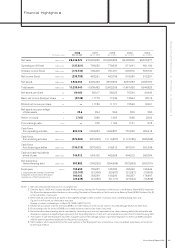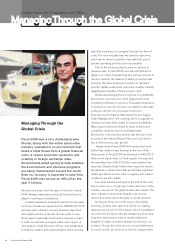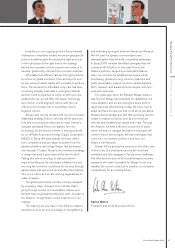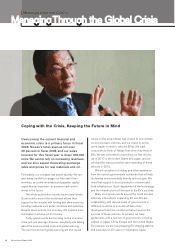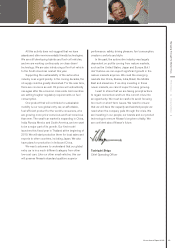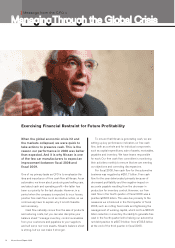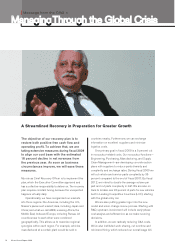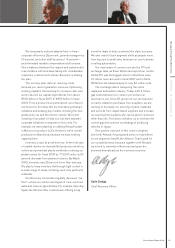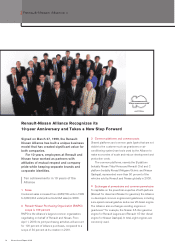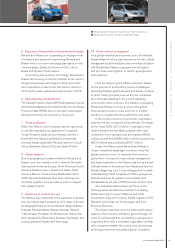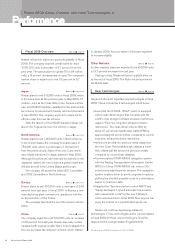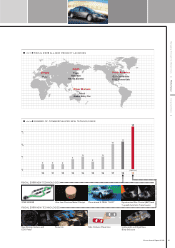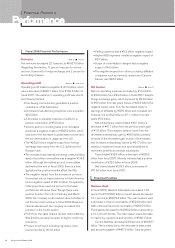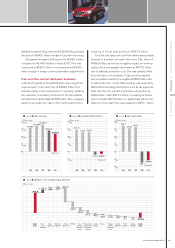Nissan 2009 Annual Report Download - page 15
Download and view the complete annual report
Please find page 15 of the 2009 Nissan annual report below. You can navigate through the pages in the report by either clicking on the pages listed below, or by using the keyword search tool below to find specific information within the annual report.
We temporarily reduced salaries here in Asia—
corporate officers by 25 percent, general managers by
20 percent, and other staff by around 15 percent—
and eliminated variable compensation and bonuses.
This is balanced between the regions and implemented
in accordance with local laws, taking into consideration
respective customs and cultures. Everyone is sharing
the pain.
The recovery plan rests on reducing costs,
because you cannot guarantee revenues. Optimizing
working capital is the best way to conserve cash, and
we’ve reduced our capital expenditures from about
¥500 billion in fiscal 2007 to ¥350 billion in fiscal
2009. From a product lineup standpoint, we refuse to
sell tomorrow for today. We are maintaining strategic
initiatives and keeping key models, including the new
global entry car and the electric vehicle. We’re still
investing in our plant in India, too, but have adjusted
corporate initiatives in response to this crisis. For
example, we were planning on utilizing Renault’s plant
in Morocco to produce LCVs. However, we’ve moved
production to Barcelona, because we have existing
capacity there.
Inventory is also at an all-time low. At the first sign
of market decline we downshifted production at all our
vehicle and powertrain plants worldwide, reducing our
global volume for fiscal 2008 by 772,000 units—a 20
percent decrease from planned volumes. By March
2009, inventory was 26 percent lower than last year.
We plan to keep inventory flat through tight control in
a wider range of areas, including used cars, parts and
materials.
Our Recovery Committee regularly discusses “car
flow”—where our stock is and types of cars—and new
sales and revenue opportunities. For example, Germany,
Spain, the UK and other countries are offering scrap
Nissan Annual Report 2009 13
Managing Through the Global Crisis Performance Corporate Data
incentive deals to help counteract the slack economy.
We also need to track segment shifts as people move
from big cars to small ones, because our core business
is selling automobiles.
Our main areas of concern now are the TIV and
exchange rates, as these factors are beyond our control.
Global TIV was the biggest shock in that there were
70 million new cars sold in fiscal 2007 and in fiscal
2009, this decreased sharply to only 54 million units.
The exchange rate is hampering the entire
Japanese automobile industry. Today, a ¥1.4 trillion
gap exists between our costs in yen versus our
revenues in yen. Since 55 percent of our yen exposure
is mainly related to purchases from suppliers, we are
working to decrease our sourcing of parts, materials
and services from Japan-based suppliers and increase
our sourcing from suppliers who can be paid in currencies
other than yen. This action will allow us to minimize the
current gap and continue our strategy of producing
vehicles in Japan.
One positive outcome of this crisis is a tighter
bond with Renault. Any proposed action or expenditure
is now aligned to benefit the Alliance. That’s good for
our competitiveness, because together with Renault,
we intend to maximize efficiencies and grow the
business dramatically as the economy recovers.
Colin Dodge
Chief Recovery Officer


